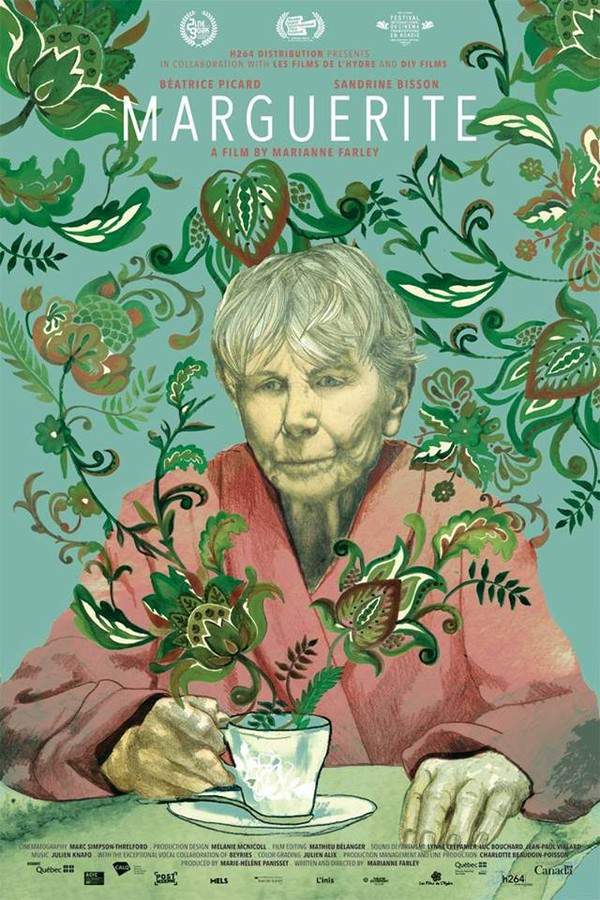
Thérèse: The Story of Saint Thérèse of Lisieux 2004
Made by

Luke Films Inc.
Thérèse: The Story of Saint Thérèse of Lisieux Plot Summary
Read the complete plot summary and ending explained for Thérèse: The Story of Saint Thérèse of Lisieux (2004). From turning points to emotional moments, uncover what really happened and why it matters.
Marie Francoise Thérèse Martin, born on January 2, 1873, was the youngest child of Saints Louis and Zelie Martin. At the tender age of four, she faced the profound loss of her mother to breast cancer, which led her to adopt her eldest sister, Pauline Younce, as a “second mother.” This experience shaped Thérèse into a delicate and spoiled child, emotionally responsive to her surroundings.
Despite her vulnerabilities, Thérèse cultivated a profound and uncomplicated love for God. On Christmas Eve in 1886, a pivotal moment transpired when she overheard her father expressing his frustration about being the one to fulfill Father Christmas’s role for her. Overwhelmed with self-pity, she hurried upstairs in tears. In a remarkable turn of events, she felt an overwhelming sense of charity flood her being, instantly transforming her demeanor and quirks.
From that life-changing moment, Thérèse became fervent in her spiritual pursuits, carrying a burning desire to save sinners from eternal damnation. She aspired to join the Carmelite monastery at just fifteen, a desire her father recognized and supported. Together, they sought permission from the bishop and even traveled to Rome, but faced disappointment initially.
However, fortune smiled upon her shortly after her return home when she received a letter granting her the permission she sought. Upon entering the Carmel of Lisieux, Thérèse began exploring the “Little Way,” a profound message she would share with the Church. Her insights emphasized God’s mercy and the importance of recognizing one’s weaknesses as a path to spiritual intimacy with Him.
Thérèse openly accepted her own failings as indicators of her reliance on God, considering herself a “Little Flower.” Unlike the majestic rose, symbolizing the great saints who impacted history, she embraced the identity of a humble daisy, dedicated to performing small acts of love for God. Her teachings provided a roadmap for ordinary individuals aspiring to holiness.
Under the guidance of Pauline Younce, now Mother Superior of the convent, Thérèse was encouraged to document her life experiences and reflections. She promptly set about writing her renowned autobiography, The Story of a Soul. Tragically, as she pursued her spiritual calling, Thérèse developed tuberculosis, a disease that had no cure during her time.
At just 24 years old, she succumbed to the illness on September 30, 1897. Yet, The Story of a Soul catapulted her into the hearts of believers around the globe, fostering a remarkable devotion to this seemingly hidden young Carmelite. In recognition of her exemplary life and the extraordinary number of miracles attributed to her after her death, she was canonized in 1924.
Decades later, in 1997, Pope Saint John Paul II honored her legacy further by declaring her a Doctor of the Church. Today, Thérèse continues to bless her devoted followers with divine roses from heaven, symbolizing her lasting impact on the faith.
Thérèse: The Story of Saint Thérèse of Lisieux Timeline
Follow the complete movie timeline of Thérèse: The Story of Saint Thérèse of Lisieux (2004) with every major event in chronological order. Great for understanding complex plots and story progression.
Birth of Thérèse Martin
Marie Francoise Thérèse Martin was born on January 2, 1873, into the loving family of Louis and Zelie Martin. As the youngest of their children, her early years were filled with affection and nurturing from her parents.
Loss of Mother
At just four years old, Thérèse faced the devastating loss of her mother, who succumbed to breast cancer. This tragedy left a profound mark on her, leading her to cling to her eldest sister, Pauline, as a second mother figure during her formative years.
Transformation on Christmas Eve
On Christmas Eve in 1886, a pivotal and emotional moment occurred when Thérèse overheard her father voicing frustration about Father Christmas. In a moment of deep self-pity, she retreated to her room but soon experienced a profound rush of charity and acceptance that forever changed her spirit.
Desire to Join the Carmelite Monastery
After her transformative experience, Thérèse developed a fervent desire to join the Carmelite monastery. At the age of fifteen, she shared this aspiration with her supportive father, who recognized her calling and assisted her in seeking permission from the bishop.
Journey to Rome
Thérèse and her father traveled to Rome to seek permission to enter the Carmelite monastery. However, they faced disappointment and were initially unable to fulfill her dream of entering religious life at that time, leaving her heartbroken but undeterred.
Permission Granted
Shortly after returning home, Thérèse received the long-awaited letter granting her permission to enter the Carmelite monastery. This news filled her with joy and excitement, allowing her to pursue the path she felt called to follow.
Entering the Carmel of Lisieux
Thérèse entered the Carmel of Lisieux, where she devoted herself to her spiritual life. Here, she began to develop and explore the concept of the 'Little Way,' which emphasized humility and the importance of loving acts towards God.
Writing 'The Story of a Soul'
Under the guidance of her sister Pauline, who had become Mother Superior, Thérèse was encouraged to document her thoughts and experiences. She began writing her autobiography, which would later become renowned as 'The Story of a Soul,' a testament to her spiritual insights.
Diagnosis of Tuberculosis
As Thérèse pursued her spiritual journey, she tragically developed tuberculosis, a disease that was incurable during her time. Despite her illness, she remained steadfast in her faith and dedication to her vocation.
Death at 24
Thérèse Martin succumbed to tuberculosis on September 30, 1897, at the young age of 24. Her death marked the end of her earthly journey, but her influence and teachings began to spread far beyond the confines of her life.
Canonization
In 1924, Thérèse was canonized, formally recognized by the Catholic Church as a saint. Her life and the miracles attributed to her intercession became a source of inspiration and devotion for countless believers around the world.
Doctor of the Church
Pope Saint John Paul II declared Thérèse a Doctor of the Church in 1997, acknowledging her remarkable contributions to spiritual teaching. This honor solidified her legacy as a significant figure in Catholic spirituality, reaching a broader audience.
Legacy of Roses
Today, Thérèse continues to bless her followers with divine roses, symbolizing her ongoing impact and connection to the faithful. The roses serve as a reminder of her love for God and her humble teachings that resonate with many seeking holiness.
Thérèse: The Story of Saint Thérèse of Lisieux Characters
Explore all characters from Thérèse: The Story of Saint Thérèse of Lisieux (2004). Get detailed profiles with their roles, arcs, and key relationships explained.
Thérèse Martin
Thérèse Martin, known for her deep spirituality and love for God, is depicted as a delicate but devoted young woman. Her openness about her weaknesses reflects her understanding of reliance on divine grace. Her commitment to executing small acts of love makes her relatable and provides comfort to many.
Pauline Younce
Pauline Younce, Thérèse's eldest sister, plays a pivotal supportive role in her life. Acting as a mother figure after their mother's death, Pauline's guidance and encouragement help shape Thérèse's spiritual journey as she enters into the Carmelite community.
Thérèse: The Story of Saint Thérèse of Lisieux Settings
Learn where and when Thérèse: The Story of Saint Thérèse of Lisieux (2004) takes place. Explore the film’s settings, era, and how they shape the narrative.
Time period
1873-1897
The late 19th century marks a period of significant religious devotion and spiritual exploration. This era saw the rise of personal piety and emphasis on individual relationships with God, leading to the emergence of various saints who inspired others through their lives and teachings.
Location
Lisieux, Rome
Lisieux is a small town in Normandy, France, known for its rich religious history and the Carmel of Lisieux, where Saint Thérèse lived and died. Rome stands as the heart of the Catholic Church and serves as a vital pilgrimage site for believers, offering a connection to spiritual leadership and tradition.
Thérèse: The Story of Saint Thérèse of Lisieux Themes
Discover the main themes in Thérèse: The Story of Saint Thérèse of Lisieux (2004). Analyze the deeper meanings, emotional layers, and social commentary behind the film.
🌼
Humility
Humility is a central theme in the story of Saint Thérèse, as she characterizes herself as a 'Little Flower,' emphasizing her small but meaningful contributions to faith. This humble approach to life and spirituality underscores the belief that even the simplest acts of love are significant in the eyes of God.
💖
Love and Charity
Thérèse's profound love for God and her charity toward others shine throughout her journey. Her transformation from a spoiled child to a devoted nun illustrates how unconditional love can lead to spiritual awakening and deep connection with the divine.
📖
Spiritual Growth
The theme of spiritual growth is portrayed in Thérèse's life as she navigates her vulnerabilities and embraces her quest for holiness. Her writings and teachings encourage individuals to recognize their weaknesses as pathways to deeper intimacy with God.
Movies with Similar Twists and Themes
Uncover films that echo the narrative beats, emotional arcs, or dramatic twists of the one you're exploring. These recommendations are handpicked based on story depth, thematic resonance, and spoiler-worthy moments — perfect for fans who crave more of the same intrigue.
Featured on this page

What's After the Movie?
Not sure whether to stay after the credits? Find out!
Explore Our Movie Platform
New Movie Releases (2025)
Famous Movie Actors
Top Film Production Studios
Movie Plot Summaries & Endings
Major Movie Awards & Winners
Best Concert Films & Music Documentaries
© 2025 What's After the Movie. All rights reserved.










